The year was 1290 . A crowd had gathered around a clearing, where broken down pillars marked the presence of an ancient temple, now long gone. A young boy, just 14 years old, leaned against one of those pillars, deep in thought. Then, he began speaking, and the crowd fell silent, listening to his every word. He spoke without any notes, translating the Bhagavat Gita, from Sanskrit, which only the pundits knew, to the language everyone in the village knew and spoke – a variety of Prakrit which developed into the Marathi language. Even as he spoke, one of the men in the audience realized how momentous this event was, and how important this composition would be. He began writing down the words the young boy spoke, and this composition was named by its author and composer, the Bhavartha Deepika – the enlightening meaning (of the Bhagavat Gita). Now, the ancient, holy text, was no longer restricted to the pundits, but accessible to all, understood easily by them, composed as it was, in their...
The last time I visited the Elephanta Caves was when I was in school. It was such a messy place that I was least interested in visiting again. Then we went on a trip to Ajanta and Ellora, and Samhith read the name ‘Elephanta’ on the UNESCO World Heritage Sites list. Once he learnt that the Elephanta caves were so near, he wanted to go, and I realized that I couldn’t put it off any longer. Once we decided to make the trip, things sort of just fell into place. We chose a Saturday when Shankar was free, and off we went to explore the caves.
The Elephanta caves are situated on an island, about 11 Km from Apollo Bunder (that’s where the Gateway of India is located). Technically, the island is part of Uran in Raigad district, but it is most easily accessible from the Gateway of India, from where it is about an hour and a half away by boat.
There are more than a hundred launches which ply between the Gateway and the island, and on weekends, every single one of them is pressed into service! The first boat starts from the Gateway at 9AM, when the caves open, and the last one starts back at 5PM from the island, when the caves close for the day.
The caves are open on all days, except Mondays. The launch costs Rs. 110 for the return journey, and for an extra Rs. 10, one can even get a seat on the deck!
The boat journey is itself part of the experience, with so many things to see that time flies past. This is one of the few places in Mumbai, where you can see flocks of seagulls at any time of the day!
Location
The Elephanta caves are situated on an island, about 11 Km from Apollo Bunder (that’s where the Gateway of India is located). Technically, the island is part of Uran in Raigad district, but it is most easily accessible from the Gateway of India, from where it is about an hour and a half away by boat.
Getting There
There are more than a hundred launches which ply between the Gateway and the island, and on weekends, every single one of them is pressed into service! The first boat starts from the Gateway at 9AM, when the caves open, and the last one starts back at 5PM from the island, when the caves close for the day.
The caves are open on all days, except Mondays. The launch costs Rs. 110 for the return journey, and for an extra Rs. 10, one can even get a seat on the deck!
The Boat Ride
The boat journey is itself part of the experience, with so many things to see that time flies past. This is one of the few places in Mumbai, where you can see flocks of seagulls at any time of the day!
The island
The island itself was originally known as Gharapuri. It is believed to have been the capital of the Konkan Mauryas, and the name literally means ‘fort city’. The only village here which is still inhabited is known by the same name. The name ‘Elephanta’ came from the Portuguese, who landed here and saw a huge stone elephant guarding the entrance to the holy cave-shrines. (For those who are interested, this elephant was broken down by the Portuguese who found them, but the pieces have been reconstructed, and the elephant is on display at the Bhau Daji Lad Museum at Byculla)
Once we reached the island, there was a mad rush for the toy train. Yes, there is a tiny toy train which takes us to the foot of the hills. It costs Rs. 10 for the return journey, but takes less than 5 minutes, and isn’t really worth all that rush! We took the train just for Samhith, and even he cribbed about how short it lasted! While returning, we simply walked alongside! That’s how slow the train is!
The steps leading to the caves looked different, and I wondered for a while, till I realized that they were actually quite clean, as compared to my earlier visit. That’s when my spirits lifted, and I actually started looking forward to the caves! The steps were lined on both sides by shops selling trinkets to T Shirts, but they were fairly well organized and no one kept walking up to me or dragged me towards their shop, so it was rather fun to walk slowly up the steps, looking at the interesting things on display! An interesting thing I noted was that many of the things here were the same that we had seen at Ajanta, and that the cost here was far, far less! So, people, those of you thinking of buying mementos at Ajanta, make a visit to Elephanta just for the shopping!
Reaching the caves, I realized why things seemed so different. I had visited the caves before they had been declared as a World Heritage Site! So, that’s what it takes to clean up a place!
The person manning the ASI counter handing out tickets seemed happy when I asked for the ASI booklet on the caves. There are probably few who buy them, since they are more expensive than the cheap booklets which are sold all over the place. When I asked about guide services, he told me that there was just one guide, and he was busy with a group. However, he encouraged us to join the group, which is what we eventually did. Incidentally, the guide services are free from 9:30AM to 1:30 PM.
History
The caves at Elephanta are believed to date back to the sixth century, to the reign of the Konkan Mauryas, who were vassals of the Chalukyas. The island was then known as ‘Sripuri’. Unlike the caves at Badami, which were built for the kings, or those at Ajanta, which were built by monks, the caves here - according to the ASI booklet – were patronized by merchants and traders! The caves apparently looked so impressive, that the Portuguese, who captured the islands in 1540, couldn’t believe that these were the work of human hands! There are various stories told about why the caves and the sculptures were defaced – while some say it was done because the Portuguese thought them to be the work of demons, some say that it was simply an attempt to destroy the Hindu influence in the area. However, it no longer matters WHY the caves were defaced and sculptures destroyed. What is important is to ensure that we do no more damage.
The main cave
There are seven rock cut caves in all, but the first is the most important one, and the only one really worth a watch. Dedicated to Lord Shiva, every available wall is covered with images of Lord Shiva in various postures or depicting stories related to him.
A little off centre is a huge temple with a lingam inside. There are entrances on all the four sides, with 8 dwarapalakas or guards at the corners. It is an impressive sight, and I had to remind myself that all this had been carved out of the rocks… not built!
At one time, this temple may have been the hub of prayers to the Lord, resounding with the echoes of chants and devotional music, but today, this temple comes alive just once a year – on MahaShivaratri – when permissions have been given for prayers to be performed.
Let me take you along with me as I circumambulate this shrine in a clockwise direction, as we traditionally perform ‘pradakshina’ –
Most of the sculptures are so badly disfigured, that we had to look really close to see the features the guide pointed out. I wish I could write about all the interesting things he told us, or all the minute details which help identify the sculptures, but this post is already getting too long, so I will limit myself to showing you the photos I took. For more details, you can see the Wikipedia page, or if you visit the caves, do buy a guidebook and read it!
The first sculpture to the left of the main entrance shows Shiva in Yoga posture. It is either Mahayogi or Yogeeshwara, though there is some speculation that it might be Lakulisha. I am mentioning this only because it is interesting to note that I had never heard of Lakulisha till last year, and since then, I have been coming across him so often…
The next wall depicts Ravana lifting Kailash. To read the story, click here. Unfortunately, the lower part of the sculpture is totally mutilated, so we can barely see Ravana, but even the upper portions aren’t very clear. Thankfully, there are better depictions of this legend at Ellora, and I will put up those pics soon!
The next panel shows Shiva and Parvati on Mount Kailash, apparently engaged in a game of dice. Unfortunately, no trace of the dice remains! Not much remains of the rest either, though again, the panel has been identified with help from similar ones at Ellora. It is believed that this shows Parvati in an attitude of mock anger, when she loses, and realizes that Shiva has been cheating during the game.
| sorry folks, this is not my own image, but taken from the net! this was the one image which did not come out even recognizable in mine :( |
The next one is a beautiful panel depicting Lord Shiva as Ardhanareeshwara – half man, half woman. It is so full of details and so beautiful, that it is a wonder anyone could break it, but again, little remains to show its beauty! To read the story of Ardhanareeshwara, click here.
We now come to the most interesting and important figure in this cave – the Maheshamurthi, also known as Mahadeva or Sadasiva , but most popularly as Trimurti. The last nomenclature of course comes from the fact that the figure has three heads, and is thus considered to be the trinity – Brahma, Vishnu and Shiva. However, a closer look reveals that the three faces actually represent the three faces of Lord Shiva himself! I am not an expert on this, so I will only mention that the three forms represented here are Tatpurusha – the central face, which is depicted as calm and serene, the creative aspect of Shiva. The right face of the Lord (left for us) represents Shiva as Aghora, the destroyer, represented with the snake in his hand; while the left face represents Vamadeva – the preserver, with a lotus in his hand. For further details, click here.
I heard an interesting story for the reason this sculpture was not destroyed by the Portuguese. It is believed that the peaceful visage of the Lord reminded them of their ancient God of Love! I wonder how true this is!
Moving on, we come to the panel representing Gangadhara Shiva. This panel depicts the story of how the river Ganga was brought down to earth by Bhageeratha, and how Shiva helps her descent. More on that story later….
We then come to the panel representing Kalyanasundaramurti – depicting the marriage of Lord Shiva and Parvati. Again, this is such a detailed and beautiful piece, but is so badly mutilated; one can barely see any details!
The next panel represents the slaying of the demon Andhakasura. This is one interesting story with a number of variations, which surely deserves a post to itself. For now, here is an image…..and a promise that more will follow later…
The final panel in the cave is that of Nataraja – probably the most famous and oft-represented form of the Lord.
There are two wings on either side of the main cave. The western wing was too dark when we visited, so we gave it a skip, but in the eastern wing, we saw another shrine with a lingam,some interesting representations of Shiva, as well as images of Ganesha and Karthikeya.
There was a panel so thoroughly destroyed that we could barely make out the outlines. I was thrilled when Samhith suggested that it could be the Saptamatrikas, and the guidebook confirmed it! Finally, all these visits to caves and temples are paying off!
We wandered around the rest of the caves for a while, but there was nothing of interest. Besides, by then the place was full of couples seeking privacy, and I thought it prudent before Samhith barged in on anyone!
The return journey was full of raucous seagulls, which Samhith enjoyed, and thus ended a memorable visit to the Elephanta Caves.

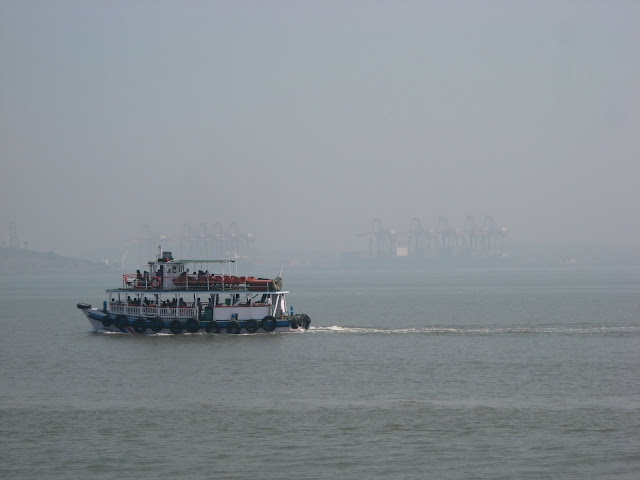
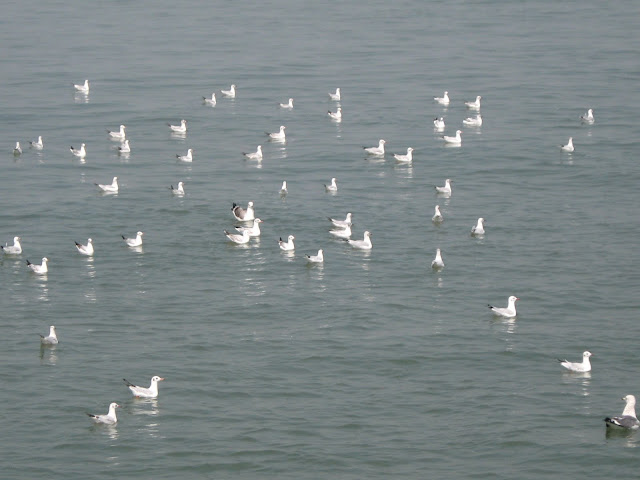







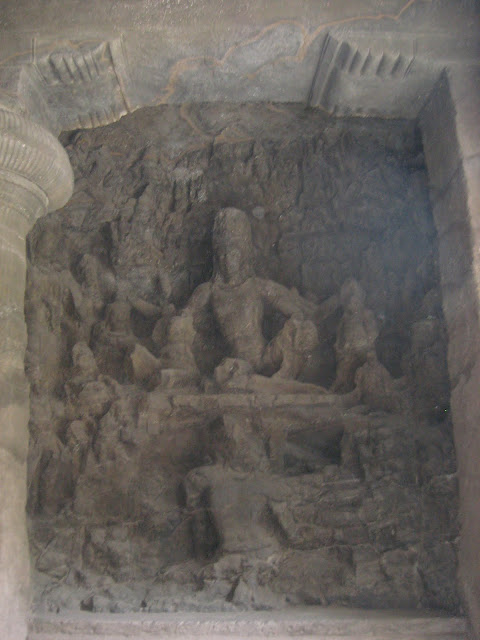
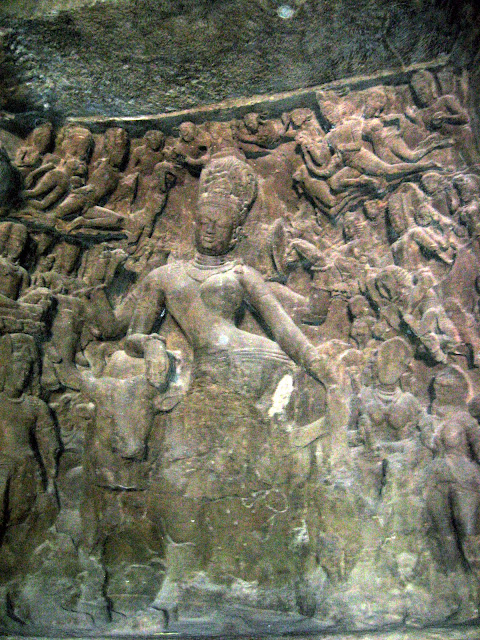

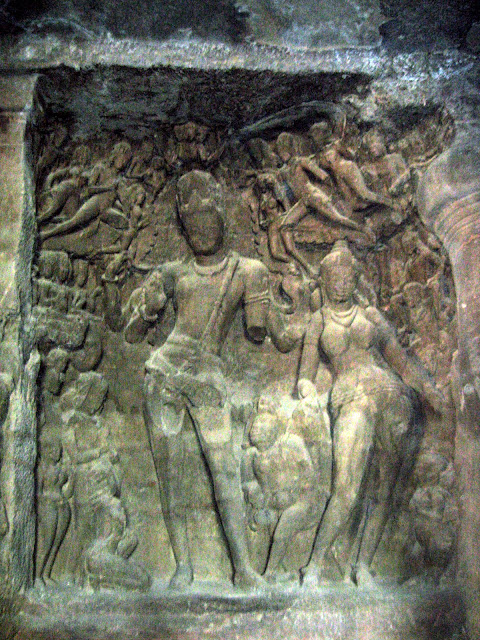



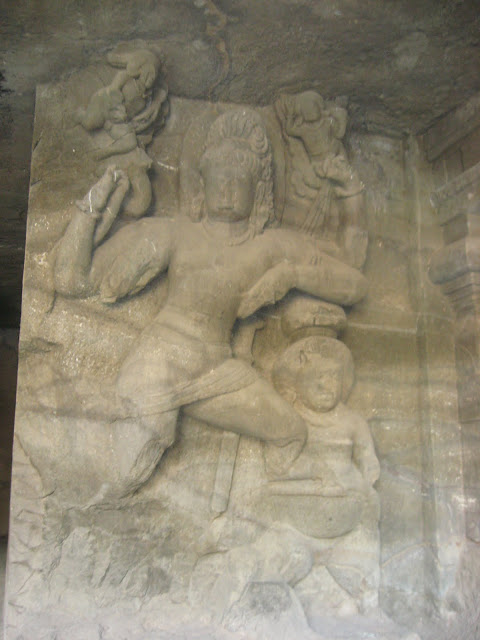


Lovely information & nice photos. Thanks for sharing.
ReplyDeleteThank you, Indiatravel!
DeleteWe have also been planning a trip to the caves with our two year old son. Your blog is quite informative. Thank you for sharing. Do we need to carry our own food or there are any eateries on the island?
ReplyDeleteThank you. yes, there are a couple of eateries on the island, tho there isnt much variety in food.
DeleteAnuradha, it was a lovely read! I am planning on visiting on 23rd August, any idea if it is open during monsoon? I could not find any information on the MTDC site.
ReplyDeleteThanks Deeksha! I really have no idea if the caves are open or not, but the boat services are off during the monsoon. so there is no way you can get to the caves, which probably means they are closed too :D in any case, the island will be partly flooded during the monsoon, so its better to wait in any case for a month or so more.
DeleteThank you for sharing ... The Elephanta Caves - T.A.I.
ReplyDeleteGreat photos and interesting information. Keep it up!
ReplyDeleteAwesome Post.. Thanks for sharing
ReplyDeleteHahaha Ive been there so many times and only today after reading your post, I learnt about Lakulisa! Incidentally there is a Lakulisa (pardon the spelling) temple on top of the Pavagadh hill near Baroda too.
ReplyDelete